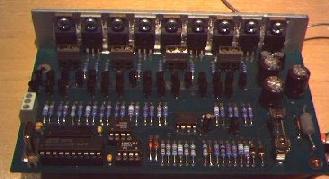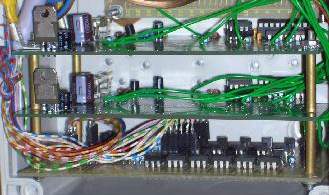LGB - a control - me-too-products

The switch module
operates turnouts, signals, uncouplers and illuminations as well as any other kind of functions which need a voltage of either 24V DC or AC. A module has four outputs to which up to four DC consumers can be connected. AC consumers and EPL-drives need two of the switch outputs because the voltage for those is created using a push-pull inverter.Configuration examples
- four illumination functions
- two illumination functions & one turnout or signal or motor function
- two turnout or signal or motor functions
Each of a switch module's outputs can bear a load of 2A, in total a module can bear a maximum of 5A. The voltage's characteristics (AC/DC, 0-24V) as well as the power-on and -off characteristics are configurable for each of the output terminals seperately (in operating mode via HTML-based instructions). Thus it is no problem at all to connect consumers of any kind (AC or DC up to 24V, 2A) to the modules directly.
Due to the configuration possibilities impressive effects are easy to realize. Letting a platform illumation come up slowly or imitating a TV-set's flickering behind a building's window are just two examples. There is nearly no limit to your creativity.
The track modules
are designed for supplying 24V DC to either a track's section or a complete line. 5A are available for the vehicles' operation (per module). Like with the Jumbo transformers, vehicle specific characterictic curves for a prototype-like acceleration and deceleration can be chosen by a click on the handheld. A modulated PWM-voltage is another feature which enables a permanent illumination of the trains.
The special modules
are used to control devices which cannot be regarded as "normal consumers" due to their technical nature. Examples in this regard are the Jumbo transformers or sound modules with the capability to invoke a number of different noises. The special modules are configurable in the same way like the other modules mentioned before and they share the same data line and power supply.
All of the modules
receive their supply voltage via their mounting holes' contacts. Screw terminals are used to connect consumers and the data line. The modules are short-circuit proof and feature both a thermic and electric overload protection. Both of the latter are self-resetting (automatic return to normal operation as soon as overload is discontinued).An optocoupler is used for a module's galvanic seperation from the RS485 bus. A RS485 transmitter is the communication link between a module's processor and the SingleChip-PC. A flash EEPROM mounted on the module is used to store its configuration.
The addressing scheme allows a maximum of 256 modules on a single RS485 bus or 1024 switch channels respectively. As the SingleChip-PC is able to control two RS485 bus systems and one also can make use of multiple SingleChip-PCs concurrently, an infinite scalability can be reached when making use of further data lines. Just in case one has to operate a few thousand turnouts...

